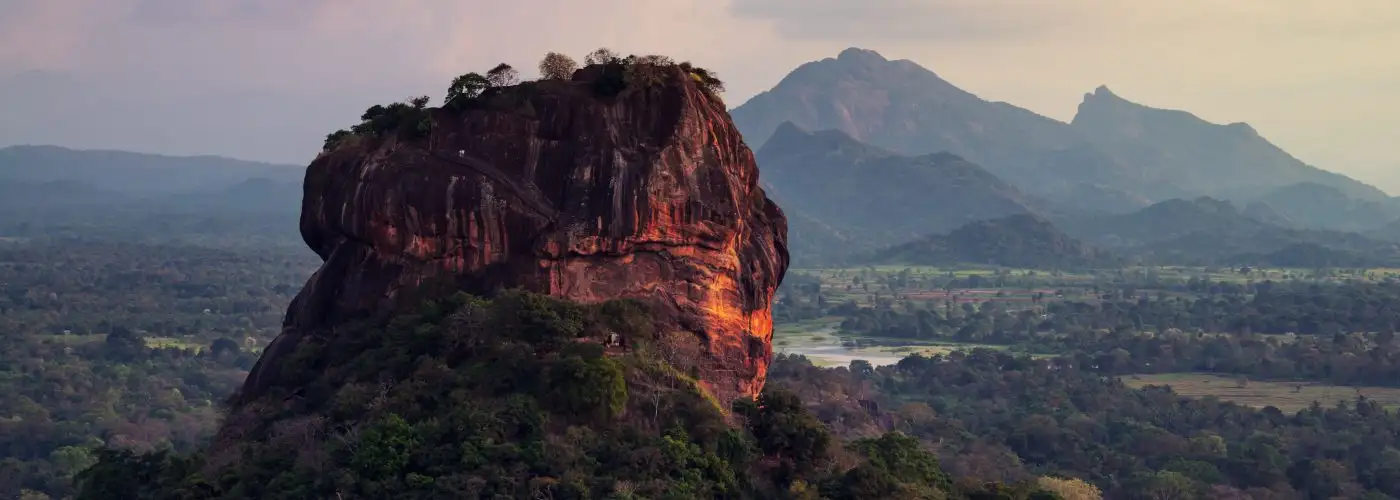There it was: A stone monolith perched high above the jungle, its rock face and sculptures weathered by many centuries. An image of Sigiriya’s peculiar limestone plateau first ignited my need to visit Sri Lanka.
A once-hidden palace to an illicit king, Sigiriya is nicknamed Lion Rock for its formerly lion-shaped peak—of which the only remaining features are a pair of massive clawed feet. The fifth-century citadel is shrouded in mystery even to the locals who know it well, so I wondered who could possibly resist scaling its steps in pursuit of its legends.
Apparently, very few of Sri Lanka’s 1.8 million yearly visitors. Sri Lanka is new to the tourism spotlight, and Sigiriya has quickly become the island’s most-visited monument. Elbow-to-elbow queues form for the chance to make it to the top of this beast, but I hoped to experience it without those crowds.
And I discovered it was possible. With the right combination of season, time of day, and guide, I was carried back in time rather than swept up in Sigiriya’s usual wave of tourists.
Climbing Sri Lanka’s Lion Rock
Image Gallery
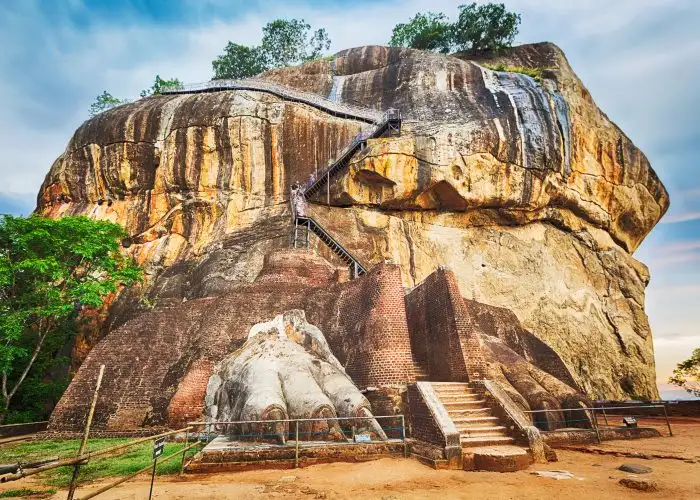
This fortress-turned-monastery is the embodiment of Sri Lanka's storied past. Sri Lanka is known as the Pearl of the Indian Ocean, and has earned its reputation as a rare gem. The country’s bounty is measured not just in its mines full of rare sapphires, rubies, and blue moonstones, but also in its rich cultural history. South Indian, Tamil, Sinhalese, Burgher, and native Sri Lankan roots shaped the many religious traditions and ancient sites that now draw modern pilgrims and tourists alike.
Visitors are new here. As recently as 2009, Sri Lanka had been closed off from the world for decades by civil war and natural disaster. In the last five years tourism has tripled, and Sri Lanka has emerged as a destination for travelers eager to see hidden Buddhist and Hindu temples, relics of Dutch and British empires, and natural wonders like mountains, rainforests, and unspoiled beaches. The island's people and traditions have so far remained unchanged despite this. They'll share their culinary and cultural traditions with any selfie-stick-toting tourist who will listen.
Because I personally wanted as few selfie sticks as possible in my path at Sigiriya, I headed to the island during monsoon season. Per advice from my small Intrepid Travel group's local guide, we ascended Sigiriya at sunrise to beat the sluggish crowds. Morning also meant a few cool hours to explore the citadel's pathways, pools, and gardens before the hot sun mounted.

This fortress-turned-monastery is the embodiment of Sri Lanka's storied past. Sri Lanka is known as the Pearl of the Indian Ocean, and has earned its reputation as a rare gem. The country’s bounty is measured not just in its mines full of rare sapphires, rubies, and blue moonstones, but also in its rich cultural history. South Indian, Tamil, Sinhalese, Burgher, and native Sri Lankan roots shaped the many religious traditions and ancient sites that now draw modern pilgrims and tourists alike.
Visitors are new here. As recently as 2009, Sri Lanka had been closed off from the world for decades by civil war and natural disaster. In the last five years tourism has tripled, and Sri Lanka has emerged as a destination for travelers eager to see hidden Buddhist and Hindu temples, relics of Dutch and British empires, and natural wonders like mountains, rainforests, and unspoiled beaches. The island's people and traditions have so far remained unchanged despite this. They'll share their culinary and cultural traditions with any selfie-stick-toting tourist who will listen.
Because I personally wanted as few selfie sticks as possible in my path at Sigiriya, I headed to the island during monsoon season. Per advice from my small Intrepid Travel group's local guide, we ascended Sigiriya at sunrise to beat the sluggish crowds. Morning also meant a few cool hours to explore the citadel's pathways, pools, and gardens before the hot sun mounted.
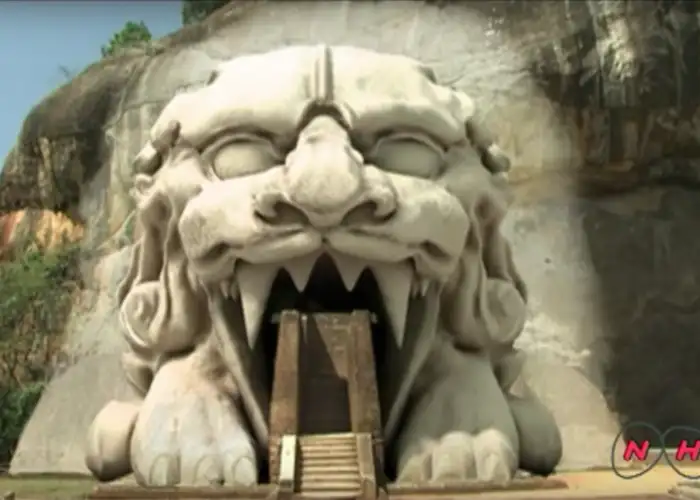
The head of a lion once guarded the entrance to Sigiriya—which is locally deemed the "Eighth Wonder of the World." This ostentatious gateway protected a patricidal ruler from his enemies.
Legend has it that Sigiriya served as ancient King Kasyapa's hiding spot from the royal sibling he overthrew to gain power in the fifth century. Kasyapa's 20-year rule came to an abrupt end when his brother returned to take back the throne in a deadly battle. Sigiriya served as King Kasyapa’s playground while he was in power, and is topped with four acres of verdant fields and placid pools. The ruins, thrones, and caverns that make up this short-lived kingdom create a sight you'd expect to find only in storybooks.
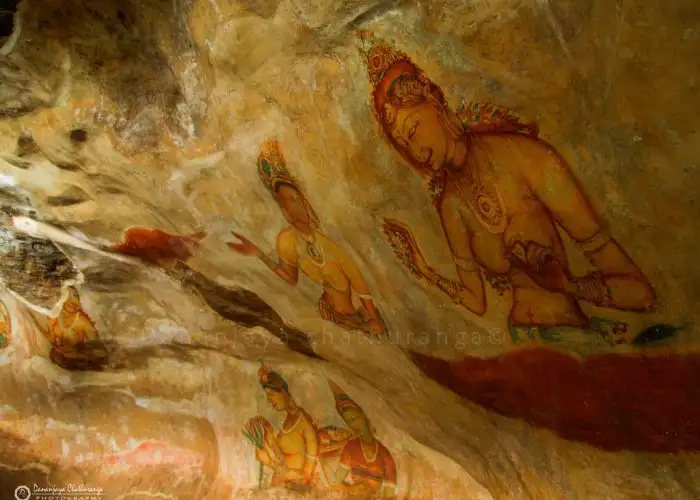
Sigiriya was once covered in frescoes depicting hundreds of nude and lavishly adorned women. Only a handful of these brightly-colored images remain, and can be seen inside one of Lion Rock's excavated galleries. The images are said to be some of the best remaining examples of fifth-century cave art, although most were removed or destroyed when Sigiriya and its surrounding gardens became a Buddhist monastery in the seventh century. Monks lived here until Sigiriya was largely abandoned in the 1300s.
The women are one of Sigiriya's mysteries—experts say their varying features and skin tones suggest they're meant to represent women of many different parts of the world. Others say they're meant to depict mystical nymphs. Some consider them to be religious figures. Many have been vandalized and damaged over the past 15 centuries—as recently as 1967. The surviving ladies can be found inside Cobra Hood Cave—a dead-end gallery now accessible by an added spiral staircase.
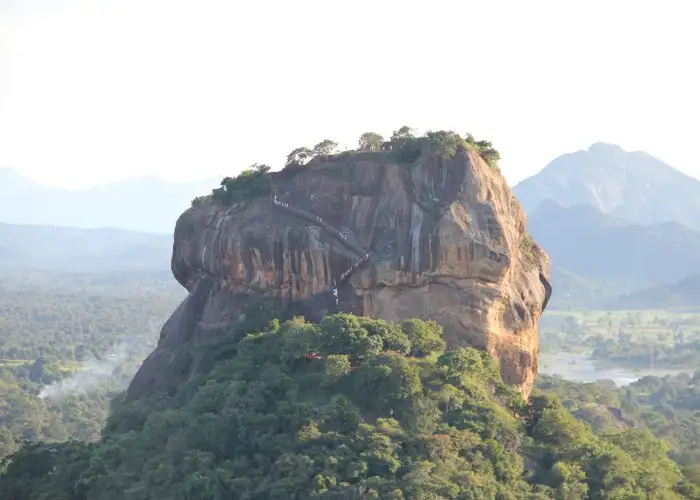
The only way to fully understand the grandeur of this complicated marvel is to climb it. Those with a fear of heights should know that this feat will place you teetering on the great rock's edge, navigating open-riser stairs reminding you of the 200 yards below with every step. It's equal parts rushing adrenaline and calming vistas.
With no crowds, Sigiriya's 1,200 steps take about 90 minutes to climb and descend. This includes stops at the natural and man-made marvels you'll come across on the way. The hike is an easy to moderate one, with flat platforms connecting staircases and providing relief from the upward trek. Two-thirds of the way up, look out over the surrounding jungle to spot giant, far-off Buddha sculptures—reduced to action-figure size from your vantage point. The dense rainforest parts only to reveal those white statues, the far-off mountain ranges, and bright clay walkways below. Wild dogs wander both the lower and upper grounds, lapping from glassy irrigation pools that once supplied King Kasyapa with all the water he could ever need.
But it's not all rosy. Prepare to sweat in the heavy humidity, even if you don't feel particularly warm in the early morning hours. Signs line the walkways and stairs warning of falling wasp's nests on windy days. Hundreds of flitting sparrows swarm alarmingly close-by overhead when storms gather in the distance.
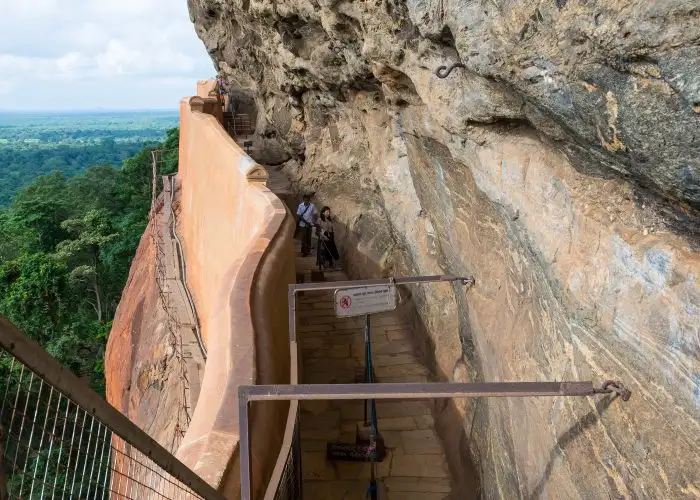
Sigiriya sits above an orange rock face that was once a polished mirror, created to cast a glow upon the base of the beast. Giving the lion the illusion of floating mid-air, the polished mirror wall was added to the rock's near-vertical slope, creating a narrow passageway that visitors can still traverse today. No longer shining, it has become a testament to the centuries Sigiriya has endured, as its inside bears etchings from visitors who wrote in Sanskrit and Sinhala as far back as 600 C.E. The graffiti and scribblings vary from poetry to documented details about the structure's appearance. One combines both, and reads:
Wet with cool dew drops
fragrant with perfume from the flowers
came the gentle breeze jasmine and water lily
dance in the spring sunshine
side-long glances of the golden hued ladies stab into my thoughts
heaven itself cannot take my mind
as it has been captivated by one lass
among the five hundred I have seen here.
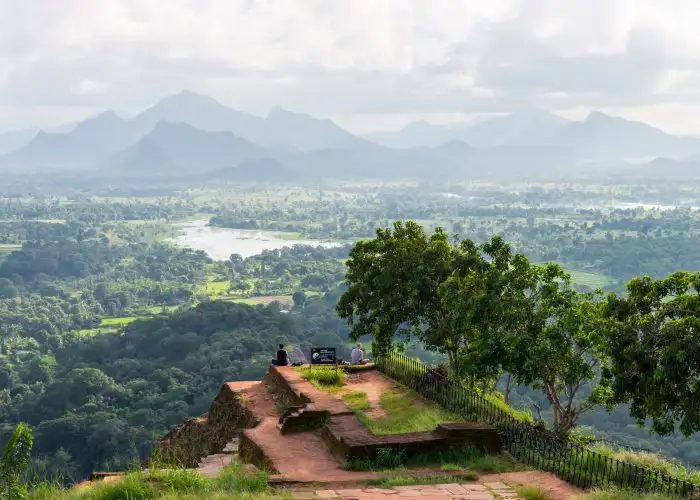
Sigiriya's peak is the citadel's shining glory, and your reward for trekking up 660 feet via winding metal and brick stairways. The palace’s top tier is a series of ruins that once served as King Kasyapa's sentry point over the jungle. A maned lion's head made of plaster and brick is rumored to be the original entryway to the palace's top tier. Now only the animal's carved claws remain, and a zigzagging cliff-side staircase behind them is the only way up.
At the top you can see royal thrones, remnants of an expansive irrigation system, and the foundations of rooms that once made up the king's living quarters. Greenery contained by wrought-iron fences only slightly block you from the rock's precarious edges.
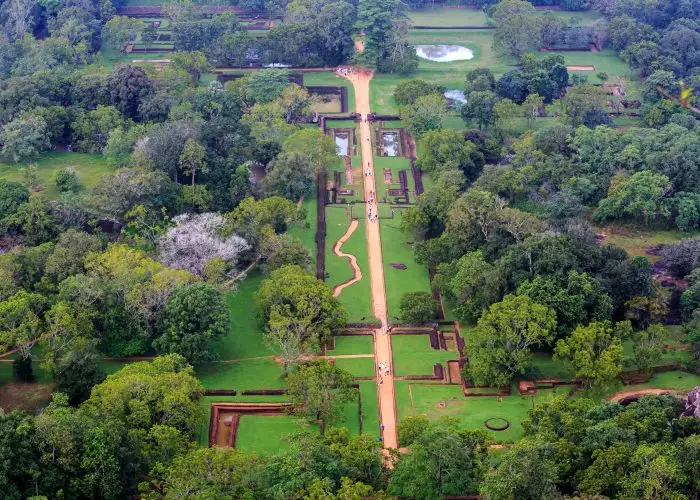
Sigiriya’s grounds aren't your standard palace gardens. The carefully placed structures and stairs make it one of the oldest-standing examples of urban planning. Historic and natural limestone formations, lotus-dotted pools, and geometrically puzzle-pieced ledges of greenery slowly change the environment throughout your ascent. At its base, Sigiriya looms in the distance beyond mossy brick walls and glassy waters rife with lily pads. Large trees jut out of centuries-old stone walls. Long, orange clay paths point you toward the towering fortress.
As you climb, rock gardens and brick walls become the main attraction. Massive stone ledges and caverns date back to the Mesolithic period, and are thought to have served as shelter for early humans. Boulders as big as houses are strewn around the slopes, and dependent stones create picturesque archways that usher you to the next climb.
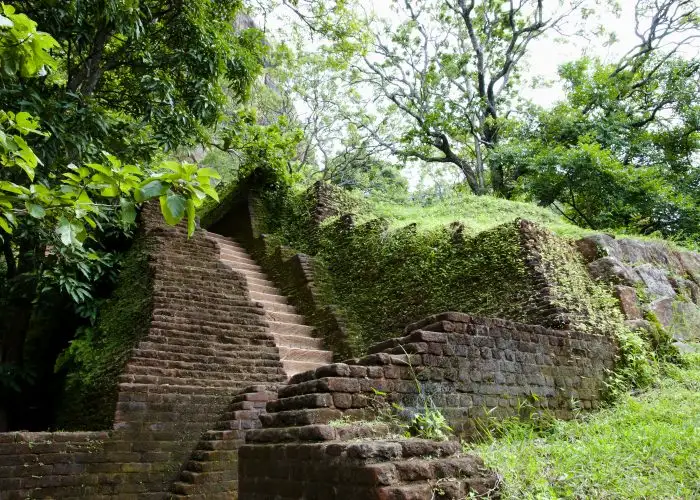
Inscriptions on drip ledges throughout the grounds echo those on the mirror wall. Sinhala and Sanskrit dominate the ancient etchings—many of which date back to the third century C.E., and some to the first century B.C.E. According to experts, many serve as records of an agreement that established the caves as monastic lodging for Buddhist monks.
But they also stand as a reminder of Sigiriya's civilizations past and present—from one very self-serving king, to selfless Buddhist monks, and now, to selfie-snapping tourists.
More from SmarterTravel:
- To Uncover the Magic of Sri Lanka, Go Small
- 11 Delicious Ways to Experience the Best of Sri Lanka
- 8 Essential Items for Monsoon Season Travel
Associate Editor Shannon McMahon writes about all things travel. She visited Sri Lanka on a Real Food Adventure as a guest of Intrepid Travel. Follow her adventures on Instagram @shanmcmahon and on Twitter @shanmcmahon_.
We hand-pick everything we recommend and select items through testing and reviews. Some products are sent to us free of charge with no incentive to offer a favorable review. We offer our unbiased opinions and do not accept compensation to review products. All items are in stock and prices are accurate at the time of publication. If you buy something through our links, we may earn a commission.
Related
Top Fares From Wichita, KS
Today's Top Travel Deals
Brought to you by ShermansTravel
Shop and Save with Country Inns...
Patricia Magaña
 Hotel & Lodging Deals
Hotel & Lodging Deals
$229 -- Chicago: Discounted Rates and...
Francesca Miele
 Hotel & Lodging Deals
$229+
Hotel & Lodging Deals
$229+
$188 -- Honolulu: Save on Oceanview...
Abigail Lamay
 Hotel & Lodging Deals
$188+
Hotel & Lodging Deals
$188+
